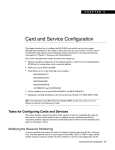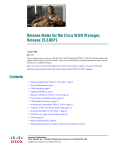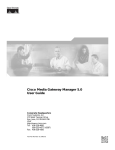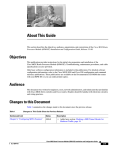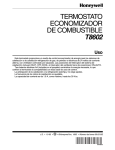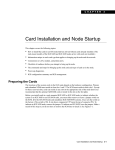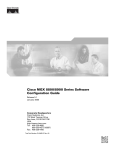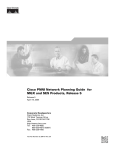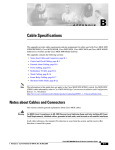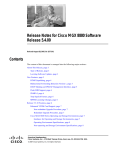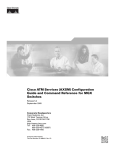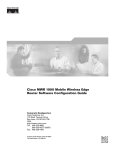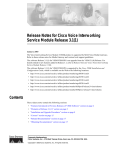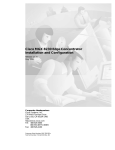Download Cisco Systems 78-12510-02 Router User Manual
Transcript
C H A P T E R 5 Configuring the MGX RPM-PR This chapter describes how to complete a basic configuration of the MGX Route Processor Module (RPM-PR). It provides procedures for configuring ATM, Ethernet, and Fast Ethernet interfaces, as well as, permanent virtual circuits (PVCs). It also details how to make connections between an RPM-PR and a PXM-45 and between other service modules or other RPM-PRs. The chapter contains the following sections: • Accessing the RPM-PR Command Line Interface • Booting the RPM-PR • Verifying the Configuration • Establishing 1:N Redundancy Between Two or More RPM-PR Cards This chapter provides information necessary to get the RPM-PR up and running. Detailed command information is available in the Cisco IOS command reference publications. Note The back cards used in conjunction with the RPM-PR are equivalent to port adapters in Cisco routers. Accessing the RPM-PR Command Line Interface To configure the RPM-PR, you must access the command line interface (CLI) of the RPM-PR. The RPM-PR CLI can be accessed using any of the following methods: • Console port on the front of the RPM-PR The RPM-PR has an RJ-45 connector on the front of the card module. If you configure the RPM-PR on site, connect a console terminal (an ASCII terminal or a PC running terminal emulation software) directly to the console port on your RPM-PR using an RS-232 to RJ-45 rollover cable for CLI access (see Chapter 3, “Installing the MGX RPM-PR”). • cc from another MGX 8850 or MGX 8950 card After initial configuration, you can also configure the RPM-PR through the PXM-45. You access the RPM-PR CLI by entering the cc (change card) command from any of the other cards in the switch. • Telnet from a workstation, PC, or another router After initial configuration, you can also configure the RPM-PR remotely via Telnet. After the RPM-PR is installed and has PVCs to other RPM-PRs or routers in the network, you can Telnet to access the RPM-PR CLI remotely from these other devices. Cisco MGX Route Processor Module (RPM-PR) Installation and Configuration Guide Release 2.1, Part Number 78-12510-02 Rev. C1, August 31, 2004 5-1 Chapter 5 Configuring the MGX RPM-PR Booting the RPM-PR To connect a modem to the auxiliary port on the RPM-PR, see Chapter 3, “Installing the MGX RPM-PR.” Booting the RPM-PR When the RPM-PR is booted, the boot image must be the first file in the bootflash. If the bootflash does not have a valid boot image as a first file, the card may not be able to boot and can result in bootflash corruption. If the bootflash is corrupted, you will have to send the card back for an external burn with a valid boot image. You can reboot the RPM-PR from the PXM by entering the command resetcd <card_number> from the switch CLI, where card_number is the slot number of the RPM-PR that is being rebooted. Note Omitting the card number resets the entire system. Also, you can reboot the RPM-PR from the RPM-PR using the RPM-PR console port and entering the reload command. Each time you turn on power to the RPM-PR, by inserting the RPM-PR into the MGX 8850 or the MGX 8950, it goes through the following boot sequence: 1. The RPM-PR runs diagnostics on the CPU, memory, and interfaces. 2. The system boot software, which is the boot image, executes and searches for a valid Cisco IOS image, which is the RPM-PR runtime software. The source of the Cisco IOS image is determined by the configuration register setting. To verify this setting, you can enter either the show version or show bootvar command. (See the “Viewing the Hardware Configuration” section later in this chapter.) • If the configuration register is set to the factory-default setting of 0x01, RPM-PR will come up and stay in boot mode. • If the configuration register is 0x2, the RPM-PR will look for the runtime image either in bootflash or on the PXM C:FW drive. 3. The search for runtime image is determined by which boot system command is entered. • Entering the boot system x:<runtime_image_name> command will result in a search for a runtime image on the PXM C:FW drive. • Entering the boot system bootflash:<runtime_image_name> command will result in a search for a run time image in the bootflash. 4. If the runtime software is not found after three attempts, the RPM-PR reverts to the boot mode. 5. If a valid Cisco IOS image is found, then the RPM-PR searches for a valid configuration, which can reside in NVRAM or as a configuration file either on the PXM hard disk x: drive or in bootflash. If you want to load from a specific configuration file, you should enter either the boot config bootflash:<config_file> command or the boot config x:<config_file> command. 6. For normal RPM-PR operation, there must be a valid Cisco IOS image on the PXM-45 x: drive or in bootflash, and a configuration in NVRAM or configuration file in bootflash or on the PXM disk. The first time you boot the RPM-PR, configure the RPM-PR interfaces and save the configuration to a file in NVRAM. Then follow the procedure described in “Initializing the RPM-PR Card.” For information on the Cisco IOS instructions, see Appendix C, “IOS and Configuration Basics.” 5-2 Cisco MGX Route Processor Module (RPM-PR) Installation and Configuration Guide Release 2.1, Part Number 78-12510-02 Rev. C1, August 31, 2004 Chapter 5 Configuring the MGX RPM-PR Booting the RPM-PR RPM-PR Bootflash Precautions The RPM-PR bootflash is used to store boot image, configuration and “run time” files. The Flash stores and accesses data sequentially, and the RPM-PR boot image must be the first file stored to successfully boot the card. Erasing the boot image or moving it from the first position on the Flash will cause the card to not boot. The RPM boot image, which comes loaded on the Flash, will work for all RPM IOS images. Therefore, there is no reason to ever delete or move the factory installed boot image. Note Erasing or moving the boot image can cause RPM-PR boot failure. When this happens, the RPM must be returned to Cisco and reflashed. In order to avoid this unnecessary failure, requiring card servicing, you should • Never erase the boot file from the RPM Flash • Never change the position of the boot file on the RPM Flash • Use care when “squeezing” the Flash to clean it up. As long as the boot file remains intact in the first position on the flash, the RPM will successfully boot. Verifying the IOS Files on Bootflash Enter the show bootflash command to verify the IOS files on the bootflash. The following screen displays the RPM-PR command sequence. Router#show bootflash: -#1 2 3 ED .. .. .. --type-image config config --crc--- -seek-- nlen -length- -----date/time-----AB6CF374 2BAFB4 11 2600756 Jul 25 2001 02:41:41 44E48EC2 34712C 18 573685 Aug 07 2001 23:03:42 7B53E8DC 40E368 18 815547 Aug 08 2001 19:28:03 name rpm-boot-mz auto_config_slot16 auto_config_slot15 28777624 bytes available (3990376 bytes used) Router# Verifying the IOS Files on the PXM-45 x: Drive The IOS image can be stored on the PXM-45 hard drive. To confirm this, make sure you are in the C:FW directory. Enter the ll command to list the contents of the directory. You should see a file with a name beginning with rpm-js-mz, which is the IOS image. Tip Copy the RPM-PR Cisco IOS image into the RPM C: directory (not the E: directory) of the PXM-45 hard disk with the filename specified in the RPM-PR boot command. The following screen displays the PXM C:FW content listing. M8850_LA.8.PXM.a > cd FW M8850_LA.8.PXM.a > ll Listing Directory .: Cisco MGX Route Processor Module (RPM-PR) Installation and Configuration Guide Release 2.1, Part Number 78-12510-02 Rev. C1, August 31, 2004 5-3 Chapter 5 Configuring the MGX RPM-PR Booting the RPM-PR drwxrwxrwx drwxrwxrwx -rwxrwxrwx -rwxrwxrwx -rwxrwxrwx -rwxrwxrwx -rwxrwxrwx -rwxrwxrwx -rwxrwxrwx -rwxrwxrwx -rwxrwxrwx -rwxrwxrwx -rwxrwxrwx -rwxrwxrwx -rwxrwxrwx -rwxrwxrwx -rwxrwxrwx -rwxrwxrwx -rwxrwxrwx -rwxrwxrwx -rwxrwxrwx -rwxrwxrwx -rwxrwxrwx -rwxrwxrwx -rwxrwxrwx -rwxrwxrwx -rwxrwxrwx -rwxrwxrwx -rwxrwxrwx -rwxrwxrwx -rwxrwxrwx 1 1 1 1 1 1 1 1 1 1 1 1 1 1 1 1 1 1 1 1 1 1 1 1 1 1 1 1 1 1 1 0 0 0 0 0 0 0 0 0 0 0 0 0 0 0 0 0 0 0 0 0 0 0 0 0 0 0 0 0 0 0 0 0 0 0 0 0 0 0 0 0 0 0 0 0 0 0 0 0 0 0 0 0 0 0 0 0 0 0 0 0 0 13312 13312 2253552 10655280 3350304 1431512 1030532 891552 303936 641312 743136 826392 10528336 7939476 1160328 468388 1245112 4069552 737896 2490064 3674368 838840 742168 297988 264592 3111904 744600 3267520 248686 4135448 4135000 May May May Apr Apr May May May May May May May May May May May May May May May May May May May May May May May May May May 11 11 11 2 2 11 11 11 11 11 11 11 11 11 11 11 11 11 11 11 11 11 11 11 11 11 11 11 11 11 11 15:47 17:10 15:47 08:46 08:46 15:47 15:46 15:46 15:46 15:46 15:46 15:38 15:38 15:38 15:37 15:46 15:37 15:37 15:37 15:37 15:36 15:36 15:36 15:46 15:46 15:36 15:36 15:36 15:32 15:32 15:32 ./ ../ mpsm_t1e1_030.000.004.016-P2.fw rpm-js-mz.123-2.T5 rpm-boot-mz.123-2.T5 mpsm_t1e1_030.000.004.016-P1_bt.fw frsm_vhs_022.000.005.019-A.fw frsm_8t1e1_022.000.005.019-A.fw cesm_t3e3_CE8_BT_1.0.02.fw cesm_t3e3_022.000.005.019-A.fw cesm_8t1e1_022.000.005.019-A.fw vxsm_005.000.004.034-A_bt.fw vxsm_005.000.004.034-A.fw pxm45_005.000.004.034-A_mgx.fw pxm45_005.000.004.034-A_bt.fw frsm_vhs_VHS_BT_1.0.06.fw mpsm155_005.000.004.034-P1_bt.fw mpsm155_005.000.004.034-P1.fw frsm12_005.000.004.034-A_bt.fw frsm12_005.000.004.034-A.fw axsmxg_005.000.004.034-P1.fw axsmxg_005.000.004.034-A_bt.fw axsme_005.000.004.034-A_bt.fw frsm_8t1e1_FR8_BT_1.0.02.fw cesm_8t1e1_CE8_BT_1.0.02.fw axsme_005.000.004.034-A.fw axsm_005.000.004.034-A_bt.fw axsm_005.000.004.034-A.fw vism_8t1e1_VI8_BT_3.2.00.fw vism_8t1e1_003.053.103.007-I.fw vism_8t1e1_003.003.103.007-I.fw In the file system : total space : 818961 K bytes free space : 704028 K bytes M8850_LA.8.PXM.a > Initializing the RPM-PR Card To initialize the RPM-PR card, please refer to the Cisco MGX 8850 (PXM1E/PXM45), MGX 8950, MGX 8830, and MGX 8880 Configuration Guide, Release 5. To verify the version, enter the show version or show bootvar commands. See the “Verifying the Configuration” section later in this chapter. Assigning an IP Address to the Switch Interface You need to assign an IP address for the RPM-PR on the ATM switch. This procedure tells you how to configure the ATM switch interface with the IP address. Timesaver 5-4 Obtain the correct IP and ATM network addresses for your RPM-PR on the ATM switch from your system administrator or consult your network plan to determine correct addresses before you continue to configure the RPM-PR. Cisco MGX Route Processor Module (RPM-PR) Installation and Configuration Guide Release 2.1, Part Number 78-12510-02 Rev. C1, August 31, 2004 Chapter 5 Configuring the MGX RPM-PR Booting the RPM-PR Step 1 Enter show ip int brief to display your router IP interfaces. Router#show ip int brief Interface Switch1 IP-Address unassigned OK? Method Status YES NVRAM up Protocol up Note that the switch does not have an assigned IP address. Step 2 Enter conf terminal to enter global configuration mode. Router#conf terminal Enter configuration commands, one per line. Step 3 End with CNTL/Z. To enter interface configuration mode for the ATM interface, enter interface switch1 at the prompt. Router(config)#interface switch1 Step 4 Enter ip address followed by the IP address to be assigned to the ATM switch. Router(config-if)#ip address 1.1.1.1 255.255.255.0 Step 5 Enter end or press Ctrl-Z to exit the configuration interface mode. Router(config-if)#end Step 6 Enter show ip int brief to display the IP address assigned to the ATM switch. The following screen is an example. Router#show ip int brief Interface Switch1 IP-Address 1.1.1.1 OK? Method Status YES manual up Protocol up Note that the newly added interface address appears in the display. Step 7 Enter show run to verify the configuration of the RPM-PR, as shown in the following example screen. Router#show run Building configuration... Current configuration : 729 bytes ! version 12.1 no service single-slot-reload-enable service timestamps debug uptime service timestamps log uptime no service password-encryption ! hostname Router ! boot system x:rpm-js-mz_002.001.000.057 boot config c:auto_config_slot11 logging rate-limit console 10 except errors enable password cisco ! ip subnet-zero no ip finger ! no ip dhcp-client network-discovery ! ! ! interface Switch1 ip address 1.1.1.1 255.255.255.0 no atm ilmi-keepalive Cisco MGX Route Processor Module (RPM-PR) Installation and Configuration Guide Release 2.1, Part Number 78-12510-02 Rev. C1, August 31, 2004 5-5 Chapter 5 Configuring the MGX RPM-PR Booting the RPM-PR switch autoSynch off ! ip kerberos source-interface any ip classless no ip http server ! ! ! line con 0 transport input none line aux 0 line vty 0 4 no login ! end Step 8 Enter copy run start at the prompt to write the configuration to the router NVRAM memory. Router#copy run start Building configuration... [OK] The IP address is now active and ready to use. Note The ATM interface can be further configured with logical subinterfaces as needed. To see how to configure subinterfaces on the ATM switch interface, see Chapter 6, “Configuring PNNI Communications,” the “Creating and Configuring a Switch Subinterface” section. Booting RPM-PR Using TFTP from a TFTP Server Once you add the IP address, you can configure the RPM-PR card to load runtime software from a TFTP server. Note This procedure is optional. The preferred procedure for loading the runtime software from the PXM-45 hard drive is described earlier in “Initializing the RPM-PR Card.” Use the following procedure to configure the RPM-PR card to load runtime software from a TFTP server: Step 1 Enter cc <RPM-PR card slot #> to access the router card. The router prompt (>) appears. Step 2 Enter enable and your password, when prompted, so that you can enter privileged commands. Step 3 Enter config terminal to enter global configuration mode. Step 4 Enter boot system tftp followed by the address of the server from which you want to download the boot file as shown in this example. Router(config)#boot system tftp /tftpboot/balbalas/rpm-js-mz 171.69.1.129 Step 5 Enter end or press Ctrl-Z to exit configuration mode. Router(config)#end 5-6 Cisco MGX Route Processor Module (RPM-PR) Installation and Configuration Guide Release 2.1, Part Number 78-12510-02 Rev. C1, August 31, 2004 Chapter 5 Configuring the MGX RPM-PR Booting the RPM-PR Step 6 Enter show run to view your configuration. The configuration is similar to the one shown here. Router#show run Building configuration... Current configuration : 710 bytes ! version 12.1 no service single-slot-reload-enable service timestamps debug uptime service timestamps log uptime no service password-encryption ! hostname Router ! boot system tftp /tftpboot/balbalas/rpm-js-mz 171.69.1.129 boot config c:auto_config_slot11 logging rate-limit console 10 except errors enable password cisco ! ip subnet-zero no ip finger ! no ip dhcp-client network-discovery Step 7 Enter copy run start at the prompt to write the configuration to the router NVRAM memory. Router#copy run start Building configuration... [OK] Step 8 To load the runtime image from the TFTP server, enter the reload command on the RPM-PR. Router#reload Configuring Ethernet Interfaces Once back card cable connections are made (see Chapter 4, “Cabling the MGX RPM-PR Back Cards” for connector descriptions and cable attachment instructions) and basic configuration on the RPM-PR is completed, you can configure Ethernet and Fast Ethernet interfaces. Preparing to Configure Ethernet Interfaces To configure interfaces in a new RPM-PR or change the configuration of an existing interface, you need to know the following information: • Internet protocol (IP) address for each interface • Network mask for each interface • Full or half-duplex connection • MGX-RJ45-FE connectors—MII or RJ-45 • MGX-MMF-FE connectors—MII or SC Cisco MGX Route Processor Module (RPM-PR) Installation and Configuration Guide Release 2.1, Part Number 78-12510-02 Rev. C1, August 31, 2004 5-7 Chapter 5 Configuring the MGX RPM-PR Booting the RPM-PR Back Card Bay and Interface Port Numbers This section describes how to identify the back card bay and interface port numbers on the RPM-PR for all back card interface types. Physical port addresses specify the physical location of each interface port, regardless of the type, on the RPM-PR. In the RPM-PR, this address is composed of a two-part number in the form <interface bay number/interface port number>, as follows: • <interface bay number> identifies the bay in which the back card is installed, either upper (1) or lower (2) bay. • <interface port number> identifies the interface port(s) on the back card. FE cards have one interface number. 4E/B cards have four numbered interfaces. For example, the following command specifies interface port 1 of the upper Ethernet back card in the RPM-PR. You need to enter this information to select a specific port on a back card or ATM interface. Router(config)#interface fastEthernet 1/1 Also, you can identify interface ports by checking the bay/interface port location on the body of the RPM-PR or by using show commands to display information about a specific interface or all interfaces in the RPM-PR. Configuring IP Addresses and Starting Ethernet Interfaces The following steps describe how to configure IP address on the 4E/B Ethernet and the FE Fast Ethernet interfaces and how to start them up. Press Return after each step unless otherwise noted. Note Step 1 RPM-PR no longer supports the MGX-RJ45-4E Ethernet interface back card. You must use an MGX-RJ45-4E/B Ethernet card with Release 2.1 or later. At the privileged-level prompt, enter the command global configuration mode as follows: Router#configure terminal Enter configuration commands, one per line. Step 2 End with CNTL/Z. To specify the interface to be configured, enter the following interface subcommand at the prompt. interface <ethernet | fastethernet> <bay>/<port> Parameter Description <ethernet | fastethernet> Interface type to be configured. <bay> Back card location; 1=upper and 2=lower back card <port> Port number on the back card Note The 4E/B interfaces are numbered 1, 2, 3, 4, not 0, 1, 2, 3 as in other IOS platforms. This example is for the upper (1) Ethernet back card in the RPM-PR in slot 11 of the switch. In this example, we configure a Fast Ethernet interface. The procedure you use to configure an Ethernet interface is identical except for specifying the Ethernet interface type. 5-8 Cisco MGX Route Processor Module (RPM-PR) Installation and Configuration Guide Release 2.1, Part Number 78-12510-02 Rev. C1, August 31, 2004 Chapter 5 Configuring the MGX RPM-PR Booting the RPM-PR Router(config)#interface fastEthernet 1/1 Step 3 You can assign an IP address and subnet mask to the interface with the ip address configuration subcommand, as in the following example. Router(config-if)#ip address 172.29.54.166 255.255.255.0 Step 4 Enter any additional configuration subcommands required to enable routing protocols and set the interface characteristics. Step 5 Start up the Ethernet interface by entering the following command: Router(config-if)# no shutdown Step 6 Configure additional interfaces as required. Step 7 When you have included all of the configuration subcommands to complete the configuration, type end or press Ctrl-Z to exit configuration mode. Step 8 Save your configuration changes as follows: Router#copy run start Selecting Half-duplex or Full-duplex Ethernet Communications Half-duplex operation is the default transmission mode for the FE back cards. The following steps describe how to configure full-duplex ethernet communications. Step 1 Enter the full-duplex command to configure full-duplex operation for the FE back cards. Router>enable Password: Router#config t Enter configuration commands, one per line. Router(config)#interface fastethernet 1/1 Router(config-if)#full-duplex Router(config-if)#end Step 2 End with CNTL/Z. Enter the show interfaces fastethernet command to verify that the 2/1 Fast Ethernet interface is now configured for full-duplex operation. Router#show interface fastethernet 1/1 FastEthernet1/1 is administratively down, line protocol is down Hardware is DEC21140, address is 0050.54ad.7c80 (bia 0050.54ad.7c80) MTU 1500 bytes, BW 100000 Kbit, DLY 100 usec, reliability 252/255, txload 1/255, rxload 1/255 Encapsulation ARPA, loopback not set Keepalive set (10 sec) Full-duplex, 100Mb/s, 100BaseTX/FX ARP type: ARPA, ARP Timeout 04:00:00 Last input never, output 1d00h, output hang never Last clearing of "show interface" counters never Queueing strategy: fifo Output queue 0/40, 0 drops; input queue 0/75, 0 drops 5 minute input rate 0 bits/sec, 0 packets/sec 5 minute output rate 0 bits/sec, 0 packets/sec 0 packets input, 0 bytes Received 0 broadcasts, 0 runts, 0 giants, 0 throttles 0 input errors, 0 CRC, 0 frame, 0 overrun, 0 ignored 0 watchdog Cisco MGX Route Processor Module (RPM-PR) Installation and Configuration Guide Release 2.1, Part Number 78-12510-02 Rev. C1, August 31, 2004 5-9 Chapter 5 Configuring the MGX RPM-PR Booting the RPM-PR 0 input packets with dribble condition detected 5 packets output, 300 bytes, 0 underruns(0/0/0) 5 output errors, 0 collisions, 0 interface resets 0 babbles, 0 late collision, 0 deferred 6 lost carrier, 0 no carrier 0 output buffer failures, 0 output buffers swapped out Router#logout Logged out Step 3 Enter the no full-duplex command to return the interface to half-duplex operation. Router#config terminal Enter configuration commands, one per line. Router(config)#interface fastEthernet 1/1 Router(config-if)#no full-duplex Router(config-if)#end Step 4 End with CNTL/Z. Enter the show interfaces fastethernet command to verify that the 2/1 Fast Ethernet interface is now configured for half-duplex operation. Router#show interface fastethernet 1/1 FastEthernet1/1 is administratively down, line protocol is down Hardware is DEC21140, address is 0050.54ad.7c80 (bia 0050.54ad.7c80) MTU 1500 bytes, BW 100000 Kbit, DLY 100 usec, reliability 252/255, txload 1/255, rxload 1/255 Encapsulation ARPA, loopback not set Keepalive set (10 sec) Half-duplex, 100Mb/s, 100BaseTX/FX ARP type: ARPA, ARP Timeout 04:00:00 Last input never, output 1d00h, output hang never Last clearing of "show interface" counters never Queueing strategy: fifo Output queue 0/40, 0 drops; input queue 0/75, 0 drops 5 minute input rate 0 bits/sec, 0 packets/sec 5 minute output rate 0 bits/sec, 0 packets/sec 0 packets input, 0 bytes Received 0 broadcasts, 0 runts, 0 giants, 0 throttles 0 input errors, 0 CRC, 0 frame, 0 overrun, 0 ignored 0 watchdog 0 input packets with dribble condition detected 5 packets output, 300 bytes, 0 underruns(0/0/0) 5 output errors, 0 collisions, 0 interface resets 0 babbles, 0 late collision, 0 deferred 6 lost carrier, 0 no carrier 0 output buffer failures, 0 output buffers swapped out Router#logout Step 5 Save your configuration changes. Router#copy run start Selecting the MII Receptacle for Ethernet Communications The RJ-45 receptacle is the default media type for the FE-TX back card. The SC receptacle (for fiber-optic connections) is the default media type for FE-FX back card. The following steps describe how to configure the MII for ethernet communications. Step 1 5-10 Enter the media-type mii command to configure the MII receptacle as the media type for the FE back cards as follows. Cisco MGX Route Processor Module (RPM-PR) Installation and Configuration Guide Release 2.1, Part Number 78-12510-02 Rev. C1, August 31, 2004 Chapter 5 Configuring the MGX RPM-PR Booting the RPM-PR Router#config t Enter configuration commands, one per line. Router(config)#interface fastethernet 1/1 Router(config-if)#media-type mii Router(config-if)#end Step 2 End with CNTL/Z. Enter the show interface command to check your configuration. Router#show interface fastethernet 1/1 FastEthernet1/1 is administratively down, line protocol is down Hardware is DEC21140, address is 0050.54ad.7c80 (bia 0050.54ad.7c80) MTU 1500 bytes, BW 100000 Kbit, DLY 100 usec, reliability 252/255, txload 1/255, rxload 1/255 Encapsulation ARPA, loopback not set Keepalive set (10 sec) Half-duplex, 100Mb/s, MII ARP type: ARPA, ARP Timeout 04:00:00 Last input never, output 1d00h, output hang never Last clearing of "show interface" counters never Queueing strategy: fifo Output queue 0/40, 0 drops; input queue 0/75, 0 drops 5 minute input rate 0 bits/sec, 0 packets/sec 5 minute output rate 0 bits/sec, 0 packets/sec 0 packets input, 0 bytes Received 0 broadcasts, 0 runts, 0 giants, 0 throttles 0 input errors, 0 CRC, 0 frame, 0 overrun, 0 ignored 0 watchdog 0 input packets with dribble condition detected 5 packets output, 300 bytes, 0 underruns(0/0/0) 5 output errors, 0 collisions, 0 interface resets 0 babbles, 0 late collision, 0 deferred 6 lost carrier, 0 no carrier 0 output buffer failures, 0 output buffers swapped out Step 3 Save your configuration changes. Router#copy run start Selecting Media Type 100 for Fast Ethernet Communications The following steps describe how to use the media-type 100 command to return the media type for the FE back cards to the RJ-45 connector or SC connector. Note Step 1 Media Type 100 is the default for fast Ethernet communications. Enter the media-type 100 command. Router#config t Enter configuration commands, one per line. Router(config)#interface fastethernet 1/1 Router(config-if)#media-type 100 Router(config-if)#end Step 2 End with CNTL/Z. Enter the show interface command to check the configuration. Router#show interface fastethernet 1/1 FastEthernet1/1 is administratively down, line protocol is down Hardware is DEC21140, address is 0050.54ad.7c80 (bia 0050.54ad.7c80) Cisco MGX Route Processor Module (RPM-PR) Installation and Configuration Guide Release 2.1, Part Number 78-12510-02 Rev. C1, August 31, 2004 5-11 Chapter 5 Configuring the MGX RPM-PR Verifying the Configuration MTU 1500 bytes, BW 100000 Kbit, DLY 100 usec, reliability 252/255, txload 1/255, rxload 1/255 Encapsulation ARPA, loopback not set Keepalive set (10 sec) Half-duplex, 100Mb/s, 100BaseTX/FX ARP type: ARPA, ARP Timeout 04:00:00 Last input never, output 1d00h, output hang never Last clearing of "show interface" counters never Queueing strategy: fifo Output queue 0/40, 0 drops; input queue 0/75, 0 drops 5 minute input rate 0 bits/sec, 0 packets/sec 5 minute output rate 0 bits/sec, 0 packets/sec 0 packets input, 0 bytes Received 0 broadcasts, 0 runts, 0 giants, 0 throttles 0 input errors, 0 CRC, 0 frame, 0 overrun, 0 ignored 0 watchdog 0 input packets with dribble condition detected 5 packets output, 300 bytes, 0 underruns(0/0/0) 5 output errors, 0 collisions, 0 interface resets 0 babbles, 0 late collision, 0 deferred 6 lost carrier, 0 no carrier 0 output buffer failures, 0 output buffers swapped out Step 3 Save your configuration changes. Router#copy run start Verifying the Configuration Enter the show commands to display the status of the all interfaces. Using the show Commands to Verify the New Interface Status In the following procedure, enter the show commands to verify that interfaces are configured and operating correctly. Step 1 Enter the show interface <back card type> <bay/port> command to specify one of the new interfaces. Verify that the first line of the display shows the correct slot number. Verify that the interface is up. When the interface and line protocol are up, this indicates that you have a working interface as shown in this example. Router#show interface fastethernet 1/1 FastEthernet1/1 is administratively up, line protocol is up Hardware is DEC21140, address is 0050.54ad.7c80 (bia 0050.54ad.7c80) MTU 1500 bytes, BW 100000 Kbit, DLY 100 usec, reliability 252/255, txload 1/255, rxload 1/255 Encapsulation ARPA, loopback not set Keepalive set (10 sec) Full-duplex, 100Mb/s, 100BaseTX/FX ARP type: ARPA, ARP Timeout 04:00:00 Last input never, output 1d00h, output hang never Last clearing of "show interface" counters never Queueing strategy: fifo Output queue 0/40, 0 drops; input queue 0/75, 0 drops 5 minute input rate 0 bits/sec, 0 packets/sec 5-12 Cisco MGX Route Processor Module (RPM-PR) Installation and Configuration Guide Release 2.1, Part Number 78-12510-02 Rev. C1, August 31, 2004 Chapter 5 Configuring the MGX RPM-PR Verifying the Configuration 5 minute output rate 0 bits/sec, 0 packets/sec 0 packets input, 0 bytes Received 0 broadcasts, 0 runts, 0 giants, 0 throttles 0 input errors, 0 CRC, 0 frame, 0 overrun, 0 ignored 0 watchdog 0 input packets with dribble condition detected 5 packets output, 300 bytes, 0 underruns(0/0/0) 5 output errors, 0 collisions, 0 interface resets 0 babbles, 0 late collision, 0 deferred 6 lost carrier, 0 no carrier 0 output buffer failures, 0 output buffers swapped out Step 2 Enter the show protocols command to display the protocols configured for the entire system and for the specific interfaces. If necessary, return to configuration mode to add or remove protocol routing on the system or specific interfaces. Verify that the line protocol is up. When the interface and line protocol are up, this indicates that you have a working interface, as shown below. Router>show protocols Global values: Internet Protocol routing is enabled FastEthernet1/1 is up, line protocol is up Switch1 is up, line protocol is up Switch1.1 is up, line protocol is up Internet address is 1.1.1.1/24 Switch1.2 is up, line protocol is up Internet address is 1.1.2.1/24 Switch1.1000 is up, line protocol is up Step 3 Enter the show running-config command to display the running configuration file. Step 4 Enter the show startup-config command to display the configuration stored in NVRAM. Verify that the configuration is accurate for the system and that each interface is the same. If they are different from running-config, you may have forgotten to enter a copy run start command. If the interface is down and you have configured it to be up, or if the displays indicate that the hardware is not functioning properly, be sure that the network interface is properly connected and terminated. If you still have problems bringing the interface up, contact a service representative for assistance. For detailed software configuration information, refer to the Cisco IOS configuration and command reference publications. These publications are available on the Documentation CD-ROM that came with your RPM-PR, or you can order printed copies. Viewing the Hardware Configuration The show version (or show hardware) command displays the configuration of the system hardware, for example, the number of each back card type installed, the software version, the names and sources of configuration files, and the boot images. Note You may not be able to view hardware configuration information using show version from a remote location. The following is an example of the show version command output. Cisco MGX Route Processor Module (RPM-PR) Installation and Configuration Guide Release 2.1, Part Number 78-12510-02 Rev. C1, August 31, 2004 5-13 Chapter 5 Configuring the MGX RPM-PR Verifying the Configuration Router#show version Cisco Internetwork Operating System Software IOS (tm) RPM Software (RPM-JS-M), Version 12.2(3.3)T, TAC Support:http://www.cisco.com/tac Copyright (c) 1986-2001 by cisco Systems, Inc. Compiled Fri 20-Jul-01 00:29 by ccai Image text-base:0x600089C0, data-base:0x61462000 MAINTENANCE INTERIM SOFTWARE ROM:System Bootstrap, Version 12.1(20001003:080040) [swtools-rommon400 102], DE VELOPMENT SOFTWARE BOOTLDR:RPM Software (RPM-BOOT-M), Version 12.2(2.3)PI, MAINTENANCE INTERIM SOFTWARE rpm9-PE1 uptime is 5 hours, 14 minutes System returned to ROM by reload at 00:05:42 UTC Sat Jan 1 2000 System image file is "x:rpm-js-mz.122-3.3.T" cisco RPM-PR (NPE400) processor with 491520K/32768K bytes of memory. R7000 CPU at 350Mhz, Implementation 39, Rev 3.2, 256KB L2, 4096KB L3 Cache Last reset from s/w peripheral Bridging software. X.25 software, Version 3.0.0. SuperLAT software (copyright 1990 by Meridian Technology Corp). TN3270 Emulation software. 1 ATM network interface(s) 125K bytes of non-volatile configuration memory. 32768K bytes of Flash internal SIMM (Sector size 256K). Configuration register is 0x2102 Viewing the Boot Variable The show bootvar command displays the boot variable, as shown in the following screen. Router#show bootvar BOOT variable = x:rpm-js-mz.122-3.3.T,12; CONFIG_FILE variable = c:auto_config_slot13 BOOTLDR variable does not exist Configuration register is 0x2102 Using show Commands to Display Back Card Information To determine which type of back card is installed in your system, enter the show rpm command. In the following example, back card information is displayed for the RPM-PR card in slot 6. Router>enable Password: Router#show rpm RPM is in chassis slot 6 PXM has ip address 172.28.128.93 Network IO Interrupt Throttling: throttle count=0, timer count=0 active=0, configured=0 netint usec=3999, netint mask usec=200 Top Assy. Part Number :800-07178-02 Part Number :73-5008-02 Board Revision :B0 PCB Serial Number :SBK0445005E CLEI Code :BAA6PT0CAA Manufacturing Engineer :00 00 00 00 MA History :00 5-14 Cisco MGX Route Processor Module (RPM-PR) Installation and Configuration Guide Release 2.1, Part Number 78-12510-02 Rev. C1, August 31, 2004 Chapter 5 Configuring the MGX RPM-PR Verifying the Configuration MA Test History :00 MA Test History :01 EPROM format version 4 EPROM contents (hex): 0x00:04 22 40 02 22 C0 46 03 20 00 1C 0A 02 82 49 13 0x10:90 02 42 42 30 C1 8B 53 42 4B 30 34 34 35 30 30 0x20:35 45 C6 8A 42 41 41 36 50 54 30 43 41 41 84 00 0x30:00 00 00 04 00 03 00 03 01 FF FF FF FF FF FF FF 0x40:04 00 FF FF FF FF FF FF FF FF FF FF FF FF FF FF 0x50:0A AA FF FF FF FF FF FF FF FF FF FF FF FF FF FF 0x60:46 D6 FF FF FF FF FF FF FF FF FF FF FF FF FF FF 0x70:00 FF FF FF FF FF FF FF FF FF FF FF FF FF FF FF 0x80:44 03 FF FF FF FF FF FF FF FF FF FF FF FF FF FF 0x90:42 82 FF FF FF FF FF FF FF FF FF FF FF FF FF FF 0xA0:0C 83 FF FF FF FF FF FF FF FF FF FF FF FF FF FF 0xB0:00 C0 FF FF FF FF FF FF FF FF FF FF FF FF FF FF 0xC0:40 41 FF FF FF FF FF FF FF FF FF FF FF FF FF FF 0xD0:82 82 FF FF FF FF FF FF FF FF FF FF FF FF FF FF 0xE0:2C AC FF FF FF FF FF FF FF FF FF FF FF FF FF FF 0xF0:FF FF FF FF FF FF FF FF FF FF FF FF FF FF FF FF 0x100:02 40 FF FF FF FF FF FF FF FF FF FF FF FF FF FF 0x110:63 51 FF FF FF FF FF FF FF FF FF FF FF FF FF FF 0x120:42 42 FF FF FF FF FF FF FF FF FF FF FF FF FF FF 0x130:00 20 FF FF FF FF FF FF FF FF FF FF FF FF FF FF 0x140:B8 17 FF FF FF FF FF FF FF FF FF FF FF FF FF FF 0x150:0C C2 FF FF FF FF FF FF FF FF FF FF FF FF FF FF 0x160:0C 2C FF FF FF FF FF FF FF FF FF FF FF FF FF FF 0x170:FF FF FF FF FF FF FF FF FF FF FF FF FF FF FF FF 0x180:62 C0 FF FF FF FF FF FF FF FF FF FF FF FF FF FF 0x190:82 6C FF FF FF FF FF FF FF FF FF FF FF FF FF FF 0x1A0:D1 CE FF FF FF FF FF FF FF FF FF FF FF FF FF FF 0x1B0:00 C0 FF FF FF FF FF FF FF FF FF FF FF FF FF FF 0x1C0:92 C8 FF FF FF FF FF FF FF FF FF FF FF FF FF FF 0x1D0:21 00 FF FF FF FF FF FF FF FF FF FF FF FF FF FF 0x1E0:0C 0C FF FF FF FF FF FF FF FF FF FF FF FF FF FF 0x1F0:FF FF FF FF FF FF FF FF FF FF FF FF FF FF FF FF See the next section, “Verifying Ethernet Connectivity,” to verify that each interface port is functioning properly. Verifying Ethernet Connectivity The ping command lets you verify that an interface port is functioning and check the path between a specific port and connected network devices. This section provides brief descriptions of the ping command. After you verify that the system has booted successfully and is operational, you can use this command to verify the status of interface ports. The remote device can be a server, a router, or a PC. The ping command sends an echo request out to a remote device at an IP address that you specify. After sending a series of signals, the command waits a specified time for the remote device to echo the signals. Each returned signal is displayed as an exclamation point (!) on the console terminal; each signal that is not returned before the specified time-out is displayed as a period (.). A series of exclamation points (!!!!!) indicates a good connection; a series of periods (.....) or the messages [timed out] or [failed] indicate that the connection failed. Following is an example of a successful ping command to a remote server with the address 1.1.1.10: Router#ping 1.1.1.10 Type escape sequence to abort. Sending 5, 100-byte ICMP Echos to 1.1.1.10, timeout is 2 seconds: Cisco MGX Route Processor Module (RPM-PR) Installation and Configuration Guide Release 2.1, Part Number 78-12510-02 Rev. C1, August 31, 2004 5-15 Chapter 5 Configuring the MGX RPM-PR Establishing 1:N Redundancy Between Two or More RPM-PR Cards .!!!! Success rate is 80 percent (4/5), round-trip min/avg/max = 1/1/1 ms Router# If the connection fails, verify that you have the correct IP address for the remote device and that the remote device is active (powered on). Then repeat the ping command. Establishing 1:N Redundancy Between Two or More RPM-PR Cards RPM-PR cards support 1:N redundancy, whereby one RPM-PR card can be configured as a redundant or secondary (backup) card for one or multiple primary RPM-PR cards, forming a redundant group. There can be multiple redundant groups in one shelf. RPM-PR 1:N redundancy is a cold redundancy, in which the configuration of a failed primary card is copied to the standby secondary card. All traffic to and from the primary RPM-PR card is switched to the secondary card after it becomes active. Because this is a cold redundancy solution, service interruption is expected. As with other service modules, the layer 2 state is restored when the secondary card becomes active. However, RPM-PR also performs layer 3 functionality, such as maintaining routing tables. The routing tables are created manually or by routing protocols, such as IGRP, BGP, or OSPF. Because routing protocols are used, the layer 3 state is restored within three to five minutes, depending on the protocol used. RPM-PR 1:N redundancy supports the following features: • Increases availability by decreasing the DPM of the network by reducing boot-up, switchover, and upgraded times. • Supports L2 redundancy and restores L3 state via reconvergence. • Support for up to 11 active (primary) RPM-PRcards per single redundant (standby or secondary) RPM-PR. • Support for a maximum of 6 redundant groups per MGX 8850 or MGX 8950. The redundant card must be present and active and must not have any connections configured. Any connection configuration will cause the addred command to be rejected. To establish a backup card for an RPM-PR card, use the following procedure. Step 1 Logon to the switch. Step 2 If you have not done so already, initialize both cards as described earlier in this chapter in “Initializing the RPM-PR Card.” Step 3 Enter the dspcds command to verify that the primary and secondary RPM-PR card are in the “Active” state. Step 4 Enter the addred command. Switch.7.PXM.a > addred <redPrimarySlotNum> <redSecondarySlotNum> <redType> Parameter Description <redPrimarySlotNum> Slot number of the primary RPM-PR card. <redSecondarySlotNum> Slot number of the secondary RPM-PR card. <redType> 2 for 1:n redundancy. Note 5-16 1 is for 1:1 redundancy which is not supported. Cisco MGX Route Processor Module (RPM-PR) Installation and Configuration Guide Release 2.1, Part Number 78-12510-02 Rev. C1, August 31, 2004 Chapter 5 Configuring the MGX RPM-PR Establishing 1:N Redundancy Between Two or More RPM-PR Cards Note Step 5 After you enter the addred command, the switch resets the secondary card; therefore, the secondary card will be unavailable for a few minutes. When the reset is complete, enter the dspcds command to show the primary and secondary cards in the active and standby states, respectively. The redundant RPM cards are shown in slots 2 and 11 with the standby card in slot 11. Switch.7.PXM.a > dspcds Switch System Rev: 02.01 Chassis Serial No: SAA03230404 Chassis Rev: B0 Step 6 Card Slot --- Front/Back Card State ---------- Card Type -------- Alarm Status -------- Mar. 19, 2001 23:14:58 GMT GMT Offset: 0 Node Alarm: MAJOR Redundant Redundancy Slot Type ----------- 01 02 03 04 05 06 07 08 09 10 11 12 13 14 Empty Active/Empty Empty Empty Empty Failed/Empty Active/Active Empty Resvd/Empty Empty Empty Standby/Empty Empty Empty Empty --RPM-PR ------AXSM_1OC48 PXM45 ------RPM-PR ------- --NONE ------MINOR NONE MAJOR ----NONE ------- --11 ------NA 08 07 ----11 ------- --PRIMARY SLOT ------NO REDUNDANCY PRIMARY SLOT SECONDARY SLOT ----SECONDARY SLOT ------- To display the redundancy relationship between all cards in the switch, enter the dspred command. Redundant cards are displayed as shown below, indicating primary and secondary slot numbers, card types, card states, and redundancy type. Switch.7.PXM.a > dspred Switch System Rev: 02.01 Mar. 19, 2001 23:15:37 GMT MGX8850 Node Alarm: MAJOR Primary Primary Primary Secondary Secondary Secondary Redundancy SlotNum Type State SlotNum Type State Type ------- ------- ----------------- --------- -----------------2 RPM-PR Active 11 RPM-PR Standby 1-n 7 Step 7 PXM45 Active 8 PXM45 Empty Resvd 1-1 Return to the primary RPM by entering the cc command, cc <redPrimarySlotNum>. Unknown.7.PXM.a > cc 2 Step 8 Enter copy run start to save the configuration to the PXM-45 hard disk E:RPM directory. This file will be used as the configuration file. The name of the file is auto_config_slot# where # is the primary slot number. Note This step is mandatory for redundancy to work. Cisco MGX Route Processor Module (RPM-PR) Installation and Configuration Guide Release 2.1, Part Number 78-12510-02 Rev. C1, August 31, 2004 5-17 Chapter 5 Configuring the MGX RPM-PR Establishing 1:N Redundancy Between Two or More RPM-PR Cards Note The standby card must not have any configurations and must not be configured. Therefore, do not provision the standby card. Using Softswitch to Change the Active Card Enter the softswitch command to manually change the active card to the standby card. You may want to do this if you need to remove the original active card from the MGX8850/8950 shelf. Before you begin this procedure, make sure that the destination card is in Standby mode. To change the active cards, follow the steps below, in which the primary or active card in slot 2 is switched to standby or secondary, and the standby card in slot 11 is switched to primary or active. Step 1 Enter the softswitch command. Unknown.7.PXM.a > softswitch 2 11 softswitch: Do you want to proceed (Yes/No)? y where 2 is the active or primary card and 11 is the standby or secondary card. The card in slot 11 is now the active RPM-PR card, and the RPM-PR card in slot 2 is reset. It comes up in standby mode after a couple of minutes. The new active card will not revert to standby mode automatically. Enter softswitch to manually switch over the active card back to standby mode. This is the only way the active card will switch over to standby, unless the active card fails. Step 2 Enter the same command to switch the active card back to the original RPM-PR. Unknown.7.PXM.a > softswitch 11 2 softswitch: Do you want to proceed (Yes/No)? y where 11 is now the active card and 2 is now the standby/secondary card. Deleting Redundancy To delete card redundancy, the primary card must be active, otherwise this command will be rejected. Enter delred followed by the primary card’s slot number, as shown here: Switch.7.PXM.a > delred 2 Redundancy link is deleted The secondary card is reset and comes back up as an active normal RPM-PR card (if it is the last primary card) that can be used for any other purpose. Note in the example below that the card in slot 11 is now active. Switch.7.PXM.a > dspcds Switch System Rev: 02.01 Mar. 20, 2001 00:00:01 GMT Chassis Serial No: SAA03230404 Chassis Rev: B0 GMT Offset: 0 Node Alarm: MAJOR Card Front/Back Card Alarm Redundant Redundancy Slot Card State Type Status Slot Type -----------------------------------01 02 03 5-18 Empty Active/Empty Empty --RPM-PR --- --NONE --- --NA --- --NO REDUNDANCY --- Cisco MGX Route Processor Module (RPM-PR) Installation and Configuration Guide Release 2.1, Part Number 78-12510-02 Rev. C1, August 31, 2004 Chapter 5 Configuring the MGX RPM-PR Establishing 1:N Redundancy Between Two or More RPM-PR Cards 04 05 06 07 08 09 10 11 12 13 14 Empty Empty Failed/Empty Active/Active Empty Resvd/Empty Empty Empty Active/Empty Empty Empty Empty ----AXSM_1OC48 PXM45 ------RPM-PR ------- ----MINOR NONE MAJOR ----NONE ------- ----NA 08 07 ----NA ------- ----NO REDUNDANCY PRIMARY SLOT SECONDARY SLOT ----NO REDUNDANCY ------- Switch.7.PXM.a > Adding Additional Primary Cards You can add one or more additional RPM-PR cards as primary cards backed up by the secondary card. To do this, enter the addred command as follows. Switch.7.PXM.a > addred <redPrimarySlotNum> <redSecondarySlotNum> <redType> Repeat this step for each additional card you want to add to the secondary card backup protection. In the following example, the primary cards in slots 2, 3, and 4 are being backed up by the secondary RPM-PR in slot 11. switch.7.PXM.a > addred 2 11 2 switch.7.PXM.a > addred 3 11 2 switch.7.PXM.a > addred 4 11 2 Upgrading Redundant RPM-PR Cards The following procedure describes how to upgrade redundant RPM-PR cards. Note Redundancy must be established as described above, before you use this procedure. Step 1 On the primary active RPM-PR card, modify the running configuration to boot from the new upgrade software. Step 2 Enter WR MEM to execute the write memory command, which saves the configuration. Step 3 Enter the softswitch command, as follows, to switch to the secondary card. switch.7.PXM.a > softswitch <fromSlot> <toSlot> This step makes the secondary card active and resets the primary RPM-PR card. When the primary card resets, it loads the upgraded software defined in Step 1. Step 4 Modify the configuration of the secondary card to boot from the new upgrade software and enter WR MEM to save the configuration. Step 5 Enter the softswitch command, as follows, to switch to the primary card from secondary card. This command is executed only after the primary card has booted and is in the standby state. switch.7.PXM.a > softswitch <fromSlot> <toSlot> This step makes the upgraded primary card active and resets the secondary card. When the reset is complete, the secondary card runs the upgrade software and is now in the standby state. Cisco MGX Route Processor Module (RPM-PR) Installation and Configuration Guide Release 2.1, Part Number 78-12510-02 Rev. C1, August 31, 2004 5-19 Chapter 5 Configuring the MGX RPM-PR Establishing 1:N Redundancy Between Two or More RPM-PR Cards Step 6 Continue this procedure from Step 2 for all remaining cards. Upgrading Non-redundant RPM-PR Cards The following procedure describes how to upgrade non-redundant RPM-PR cards. 5-20 Step 1 Configure the RPM-PR card to store its configuration on the PXM hard disk by entering the boot config e:auto_config_<slot#> command or by saving it in NVRAM by entering the WR MEM command. Step 2 Modify the running configuration to boot from the new upgrade software by entering the boot system command. Step 3 Enter WR MEM to save the configuration. Step 4 Reset the RPM-PR card by entering the reset command from the PXM or the reload command from the RPM-PR. Cisco MGX Route Processor Module (RPM-PR) Installation and Configuration Guide Release 2.1, Part Number 78-12510-02 Rev. C1, August 31, 2004




















